How to deal with legacy systems and where to put the data
The situation is all too familiar: IT systems grow and thrive, and users become hunters and gatherers of data. Sooner or later, you inevitably must...

Software development has evolved rapidly in recent years, and low-code has proven to be one of the most disruptive technologies helping organizations accelerate their digital transformation.
In this article, we provide an overview of how low-code is being used in product developement to bring innovative solutions to market faster than ever before. We aim to focus on an equally intriguing and relevant topic: how is low-code utilized in the development of cloud products at Natuvion?
At a time when markets are becoming ever more demanding and customers are constantly asking for new and improved products, the speed of product development is crucial. Traditional software development is often unable to keep up with the rapid changes in the digital world, leading to bottlenecks and long development cycles. This is where low-code comes into play. Low-code development enables companies to create applications and products with a visual, user-friendly interface and minimal hand-coding. This opens completely new possibilities for fast iterations and agile working. Developers can design, develop, and deploy prototypes and solutions in less time. At the same time, subject matter experts without in-depth programming knowledge can actively participate in the development process, which leads to greater involvement of the entire organization.
Low-code has been an integral part of cloud product development at Natuvion for some time now. Not only are the first prototypes for our own products generated using our in-house Product Factory, but the resulting products are also characterized by a significant amount of low-code functionality.
These functionalities also enable non-developers to extend the products effortlessly. We have combined this comprehensive range of options under the term ‘Cloud Product Factory’. The Cloud Product Factory is made up of the following components:

In the scenario described above, low-code is primarily used in the Natuvion JAMES code generator and in the cloud applications generated with it.

The use of low-code enables the rapid realization of prototypes and MVPs (minimum viable products). Natuvion's Cloud Product Factory enables ideas to be quickly turned into prototypes and MVPs. These successive development cycles enable developers to obtain feedback from stakeholders and customers at an early stage. This allows the right functions and features to be identified and the product to be continuously optimized. Natuvion's cloud development team not only uses the Cloud Product Factory for the (further) development of its own products, but also continues to develop them based on the latest findings. Numerous cloud products that are now successfully in operation (cf. list below) originally started as generated prototypes and were then continuously developed further until they reached the status of a marketable product.
The possible applications are almost limitless. At Natuvion, we now have many prototypes, for example for incoming invoice verification (RPA with OCR recognition and workflow functionality) or AI-supported workforce scheduling (linking several different source systems with an AI running on MS Azure). There are also further opportunities in the ‘cloudification' of legacy applications. This involves migrating existing applications in whole or in part to the cloud. By using prototypes, intermediate results can be generated very quickly and iteratively, which in turn helps to minimize the project risk.
Low-code goes beyond the status of a mere trend. When used correctly, it serves as a driving force for efficiency and innovation in product development. It helps companies to develop their concepts more quickly and maintain their competitiveness. As outlined in the article “Low-code - hype or savior” from our last nVision (page 74), low-code functionality has already found its place in the development of cloud products. In the next part of the article series, we will use specific examples to illustrate how low-code is used effectively in the implementation of prototypes and cloud products.

The situation is all too familiar: IT systems grow and thrive, and users become hunters and gatherers of data. Sooner or later, you inevitably must...

In recent years, few topics have been discussed as intensely in the SAP industry press as the end of maintenance for SAP ERP 6. The industry press is...

Successful transformations require careful planning, accurate system insights, and a clear strategy. Companies should have a clear vision, choose the...